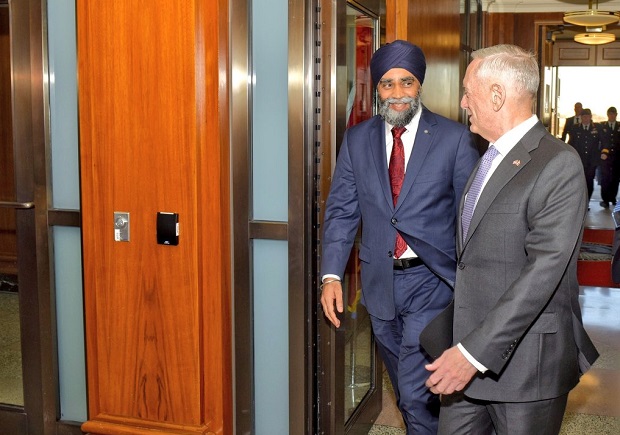“Great meeting with #SecDef Mattis today,” Canadian Minister of National Defence Harjit Sajjan tweeted yesterday after his tete-a-tete at the Pentagon yesterday with his American counterpart, Secretary of Defence Jim Mattis.
The meeting between the two former soldiers has been described as friendly and productive but little details were released to the media leading to some questions as to how the Canadian government will be interacting with the new Trump administration on issues such as NATO, peacekeeping missions, and fighter jet procurement program. This was the first ever meeting between members of Prime Minister Justin Trudeau and United States President Donald Trump’s cabinet.
A statement from the DND was characteristically short on details.
“The warm, cordial tone of the discussion reflects the long-standing, close partnership between Canada and the United States, particularly when it comes to defence and security,” a statement from Sajjan said. “The close defence relationship between our two nations provides both countries with greater security in North America and contributes to peace and stability in the world in increasingly complex and uncertain times.”
![]()
Sajjan said he and Mattis also discussed multilateral issues such as the two countries’ pledges to lead battle groups that will enhance NATO’s presence in Eastern Europe, the U.S. and Canada’s commitments to the United Nations, and the Summit of Defence Ministers which Canada will host later this year.
He said he also discussed training missions in Ukraine and Iraq and the coalition efforts to destroy the terrorist group, Daesh.
“We discussed Canada’s decision to launch an open and transparent competition to replace our legacy fleet of CF-18 fighter aircraft, and to explore the immediate acquisition of 18 new Super Hornet fighter aircraft as an interim capability,” Sajjan said. “I expressed my appreciation to the secretary for the support and cooperation of the US Government in these processes.”
In an interview with the Canadian Press, an American military analyst said he hoped the issue of NATO and protecting Eastern Europe from Russian aggression would be discussed.
Steve Saideman, an international relations scholar at Carleton University in Ottawa, said that the particular NATO issues discussed in the meeting would provide Canada with “some guidance on what’s going on in this administration.
Saideman also said he hopes Canada’s peacekeeping strategy and the country’s CF-18 replacement program would be discussed by Mattis and Sajjan.
While Mattis and Sajjan were talking with each other about enhancing NATO’s presence in Eastern Europe, U.S. President Donald Trump was speaking to American soldiers in MacDill Air Force Base in Florida.
On several occasions during his campaign, Trump had dismissed NATO as being “obsolete.”
He has repeatedly ranted against countries that did not adequately contribute to running NATO.
Members countries of NATO make direct and indirect contributions to the alliance.
Indirect, or national, contributions are the largest and come, for instance, when a member volunteers equipment or troops to a military operation and bears the costs of the decision to do so, according to NATO.
Direct contributions are made to finance requirements of the alliance that serve the interests of all 28 members – and are not the responsibility of any single member – such as NATO-wide air defence or command and control systems. Costs are borne collectively, often using the principle of common funding.
In 2006, NATO member countries agreed to commit a minimum of two per cent of their gross domestic product (GDP) to defence spending.
Canada commits only roughly half of that amount. However, Canada makes up for it by being involved in more NATO missions.
Recently, Trump has said would decide whether or not to protect alliance members against Russian aggression based in whether those countries “have fulfilled their obligation to us.”
However, during his talk with the troops in Florida yesterday, the U.S. president appears to have dialed down the rhetoric saying instead that “we support NATO.”

